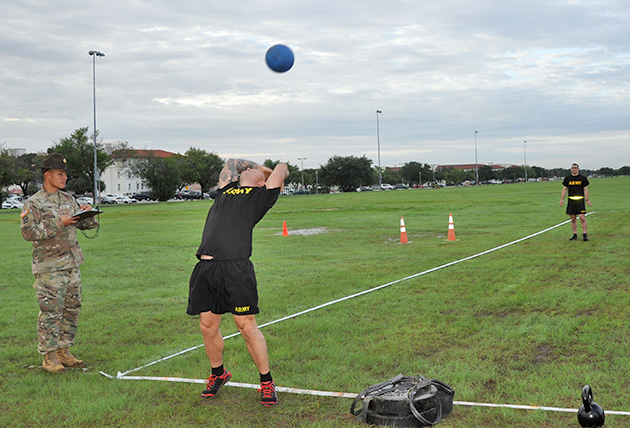This test involves throwing a Power Ball (or medicine ball) for maximum distance. The Overhead Power Ball Throw was once part of the SPARQ assessment for basketball and soccer, and the protocol that they used is listed here. This test is also a part of the US Army Army Combat Fitness Test, called the Standing Power Throw, using a 10lb (4.5kg) medicine ball. There is a similar back throw test using a 8lb shot put.
purpose: this test measures core strength and total body power.
equipment required: 2 or 3 kg power ball (boys use a 3kg, girls and youth use 2kg), tape measure, clear open area for testing.
pre-test: Explain the test procedures to the subject. Perform screening of health risks and obtain informed consent. Prepare forms and record basic information such as age, height, body weight, gender and test conditions. Check the weight of the ball. The start line should be clearly marked. Perform a standard warm-up. See more details of pre-test procedures.
 Power Ball Backwards Overhead Throw
Power Ball Backwards Overhead Throwprocedure: The athlete starts by standing facing away from the direction they are going to throw, with their heels at the start line. The starting position is with the ball in both hands, held above the head, with arms extended. Keeping the arms extended, swing the ball down between your legs while flexing the knees. Then in one motion the ball is flung up and back over the head (optimally at about 45 degrees). Several practices may be required to get the best trajectory for maximum distance. The athlete is permitted to fall backward over the line after the ball is released. Three attempts are allowed.
scoring: The distance from the starting line to where the ball first lands is recorded. The measurement is recorded to the nearest foot. The best result of three throws is recorded.
results: US Decathlete Bryan Clay achieved 77 ft 7 in in this test during a SPARQ testing exercise (published in SPARQ Magazine, Summer 2008).
target population: basketball, and other sports in which total body power is important.
advantages: this test is easy and quick to perform for an individual, with the equipment required relatively cheap.
disadvantages: several people are needed to conduct this test smoothly: one to mark where the ball lands and take the measurement, another to check technique and another to collect and return the balls. If testing a large group of participants, it can be time consuming to put all of them through this test.
comments: The angle the ball is thrown is important. You may want to explain to the subject about the optimal angle for maximal distance, and to allow some practice attempts.
The Test in Action
- This test was once part of the SPARQ assessment for basketball and soccer
- This test is also a part of the US Army Army Combat Fitness Test (called the Standing Power Throw)
Similar Tests
- Kneeling Power Ball Overhead Throw (forwards)
- Medicine Ball standing overhead throw
- Powerball backwards overhead throw
- Shot put back throw
Related Pages
- Medicine and Power Ball Fitness Tests
- About the US Army Army Combat Fitness Test
- About Medicine/Power Balls
- The SPARQ rating system for basketball and soccer
- SPARQ fitness rating system
- Other speed and power tests
- Medicine balls for sale


 Current Events
Current Events